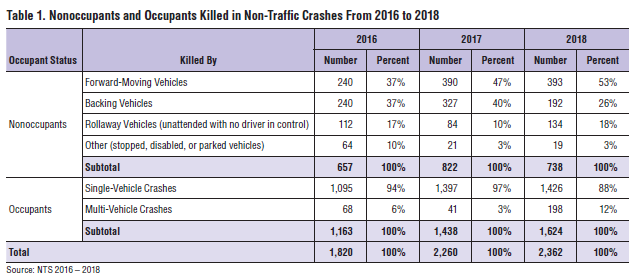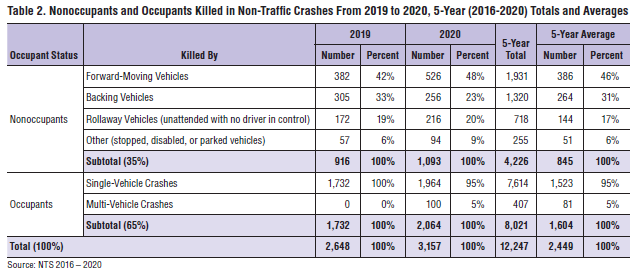September 27, 2022
It’s been four years since the National Highway Traffic Safety Administration published an analysis of Non-Traffic Surveillance Data, which includes an estimate of the annual toll of rollaway injury and deaths. But the newest numbers are out, and despite some wonky data – blamed on the pandemic – rollaway is pretty much the same threat to public safety it’s always been.
It’s been a long dry spell since NHTSA’s National Center for Statistics and Analysis has published an accounting of rollaway injuries and death, but last week, NHTSA released new stats covering a five-year period, from 2016 to 2020.
During that time, an estimated 12,247 people were killed in non-traffic crashes, averaging 2,449 people each year. Rollaways accounted for 17 percent of the total, with an average of 144 deaths per year. On average, rollaway vehicles injured about 1,886 nonoccupants each year, about 7 percent of that total.


Non-Traffic Surveillance: Fatality and Injury Statistics in Non-Traffic Crashes, 2016 to 2020 noted that: “In this 5-year period, 2020 has the lowest number of people injured in non-traffic crashes and the highest number of people killed in non-traffic crashes – a phenomenon also observed in other National Highway Traffic Safety Administration traffic crash data systems, the Fatality Analysis Reporting System (FARS) and the Crash Report Sampling System (CRSS), possibly because of the COVID-19 pandemic and its related lockdown.”
Some history: Despite the significance of the problem, it took a concerted campaign by safety advocates to persuade Congress that NHTSA ought to be tracking all sorts of vehicle-related safety issues that do not occur on the public roadways – such as SUVs with poor rear field-of-vision, resulting in backovers, or vehicles lacking countermeasures to prevent rollaway. The 2005 Safe, Accountable, Flexible, Efficient Transportation Equity Act: A Legacy for Users (SAFETEA-LU) compelled the agency to collect non-crash death and injury data. And, in 2007, the Cameron Gulbransen Kids Transportation Safety Act of 2007 (K.T. Safety Act) required NHTSA to create and establish a database of such incidents. Besides FARS and the CRSS, NHTSA also uses vital statistic databases and the State Data System of police crash reports to arrive at its estimates.
These analyses began to dribble in April 2014, with subsequent updates in 2016, 2018 and 2022. Over the years, the numbers and percentages of rollaway injuries and deaths have edged up and down.
The first of the three “Not-In-Traffic-Surveillance Fatality and Injury Statistics in Non-Traffic Crashes” reports was published in April 2014 and included data from calendar years 2008-2011. The report tallied 370 fatalities to nonoccupants in rollaways, accounting for about 15 percent of the total of all nontraffic incidents. Injuries during that period totaled 8,000, approximately 6 percent of the total.
In August 2016, NHTSA’s NCSA released its second analysis of not-in-traffic incidents covering calendar years 2012-2014, and found that rollaway vehicles killed 360 nonoccupants during the 3-year period, averaging 120 fatalities per year and accounting for 19 percent of the nonoccupants killed in non-traffic crashes. It also found that an average of 2,000 injuries occurred each year due to rollaways.
The April 2018 publication covered calendar year 2015, noted 142 fatalities in non-driver controlled rollaways and approximately 2,000 non-occupant injuries, accounting for 17 percent of all the nonoccupants killed and injured in non-traffic crashes.
As these data have been collected, some manufacturers have been rolling out in-vehicle rollaway prevention strategies. For example, Fiat-Chrysler Automotive’s Safehold, a software-enabled feature that automatically activates the Electronic Parking Brake to prevent rollaway if the driver exits an unsecured vehicle, debuted on the 2014 Jeep. Some models with electronic shifters employ a strategy in which the transmission will automatically shift to Park if the driver fails to do so before exiting the vehicle, such as Ford’s Return to Park. Despite the significance of the rollaway problem and feasible prevention strategies, implementation throughout the fleet has been slow and spotty.
Meanwhile, another act of Congress, the Infrastructure Investment and Jobs Act, signed into law by President Biden on November 15, 2021, requires NHTSA to finish an evaluation of technology to prevent keyless ignition vehicles from rolling away, and present it to Congress with recommendations for further study or action. Will this data shape NHTSA’s ultimate recommendations?